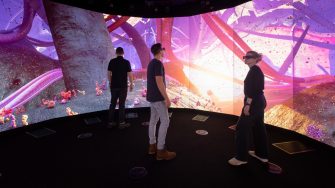UNSW introduces world-leading 3DXLab
With the metaverse firmly in its sights – creative thinking, Virtual Reality (VR) and 3D visualisation are driving a new era of innovation, engagement and insight at UNSW’s new 3DXLab.
With the metaverse firmly in its sights – creative thinking, Virtual Reality (VR) and 3D visualisation are driving a new era of innovation, engagement and insight at UNSW’s new 3DXLab.

UNSW is combining two of its most innovative virtual reality and immersive display labs to create the 3DXLab and bring together 3D visualisation expertise (3DVAL) and immersive display technologies (EPICentre) to create a world-leading one stop research hub for immersive experience design, storytelling and collaboration.
The 3DXLab will be led by UNSW’s Scientia Associate Professor John McGhee, an award-winning 3D computer artist and research leader whose work sits at the nexus of immersive technology, computer animation and arts-led visualisation.
A/Prof. McGhee says while there’s a clear appetite for understanding scientific research that affects us, the complexity of information is often a barrier. Three-dimensional visualisations, however, can help make what is complex and raw more comprehensible. And similarly, while there are many organisations focused on owning the metaverse infrastructure, there is a pressing need for creative and experimental research approaches to how these spaces look, function and holistically feel for users.
“Designers and artists are critical in articulating research and deploying outcomes in a cultural environment, or an applied context in the world. The creative arts will be fundamental to solving the most pressing challenges society faces,” says A/Prof. McGhee.
“I’m passionate about making the invisible visible, enabling information to be made more accessible and understandable. The 3DXLab will bring together researchers in storytelling, computer arts, 3D visualisation together with immersive designers and software engineers to explore how we build meaningful future virtual spaces – or worlds.
“As the metaverse grows and takes shape, the ability to design virtual environments that are meaningful to different audiences using immersive technologies becomes an increasingly important consideration for researchers at the forefront of the XR [extended reality] revolution. Virtual environments will become more ubiquitous in our day-to-day lives but not enough research is really asking the questions about what these environments will look like, or what the users holistic experience will be – the focus to date has tended to be on the hard technology questions.”
The 3DXLab will build on expertise developed through creating immersive narratives turning, for example, microscopic worlds into VR spaces humans can walk through, revealing the effects of stroke on blood vessels or medication on cancer cells, among many other projects.
“A lot of important scientific work in cancer, for example, can be quite abstract or caught up in the data,” says A/Prof. McGhee. “But by using design to present the data in a way that is more tangible using contemporary media like virtual reality (VR) and 3D animation, it allows us to tell a unique story that everyone can make sense of.
“You could argue that all of those projects are really about building a world in an immersive narrative so people can make sense of it and move around in it as if they're there,” says A/Prof. McGhee.
And this is true of spaces beyond biomedical visualisation and medicine. “We have research projects in agriculture, transport, and aviation. The opportunities to apply arts and design led approaches to create virtual realities are far reaching and our research as we build our metaverse projects will have application in education, training, simulation, biomedical communication, accessibility and recording historical moments and people.”
The 3DXLab is already engaged in several cross-faculty, cross-institution and industry-led research projects, notably with UNSW Medicine, UNSW Science, Monash University and the University of Queensland, in addition to industry-aligned projects involving St Vincent’s Hospital in Sydney, the Garvan Institute, Melbourne Science Gallery, the Australian Museum, Syngenta Australia, Toll Air Ambulance and Transport for NSW.